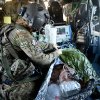Explosions are the primary way American soldiers get injured on the battlefield these days. Internal bleeding within the lungs is particularly dangerous and requires immediate care, but the time it takes before an injured soldier reaches a military hospital is often too long for survival. Researchers at Virginia Tech and Case Western Reserve University have developed special nanoparticles that can be systemically injected into a patient right after a blast injury to help with internal clot formation and to reduce inflammation within the lungs.
The hemostatic dexamethasone nanoparticles (hDNP) were loaded with corticosteroid and injected into laboratory rats subjected to trauma. They showed that compared to the control group, the rats that received the new therapy had much higher blood oxygen levels while having less internal bleeding and cellular tissue damage.
In response to the lack of therapeutics for internal bleeding following a traumatic event, we synthesized hemostatic dexamethasone nanoparticles (hDNP) to help alleviate internal hemorrhaging. hDNP consist of a block copolymer, poly(lactic-co-glycolic acid)-poly(l-lysine)-poly(ethylene glycol) conjugated to a peptide, glycine-arginine-glycine-aspartic acid-serine (GRGDS). These particles were evaluated as treatment for primary blast lung injury in a rodent model. Animals were randomly placed into test and control groups, exposed to blast and given immediate injection. Recovery was assessed using physiological parameters and immunohistochemistry. We found that dexamethasone-loaded hemostatic nanoparticles alleviate physiological deprivation caused by blast injury and reduce lung injury damage.
source:pubs.acs.org
Nanoparticles That Control Internal Bleeding After Explosive Blasts

